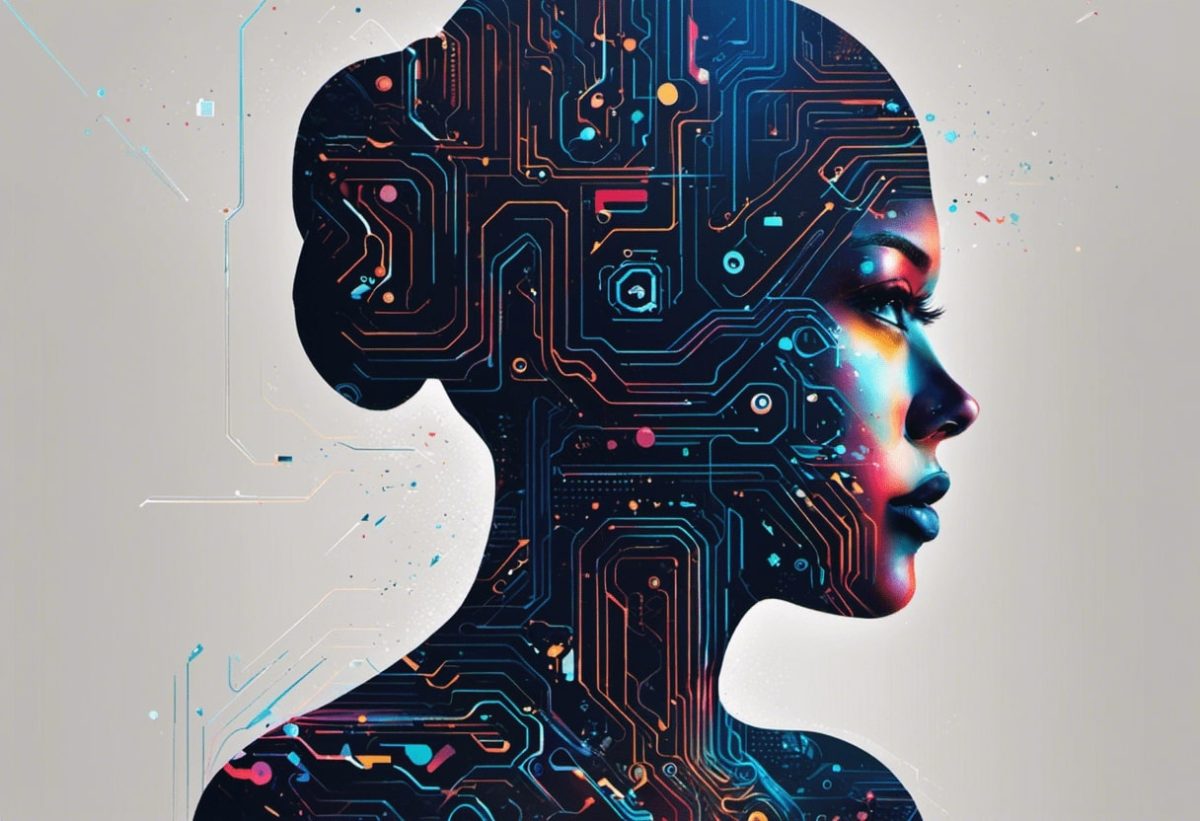Table of Contents
In the digital age we live in, image is everything.
Create in seconds:
- Blog articles and social media posts
- High-quality professional images and graphics
- Personalized translations and product descriptions
All tailored for you—original and fast.
In this article, we will explore the crucial role that Artificial Intelligence is playing in the transformation of digital graphics and design. We will see how AI is changing the way we design, produce, and interact with visual content, opening new creative opportunities and challenging past conventions. Get ready to discover how Artificial Intelligence is revolutionizing our visual world, redefining what’s possible in digital design.
The Advantages of Using Artificial Intelligence in the Design Industry: Efficiency and Innovation.
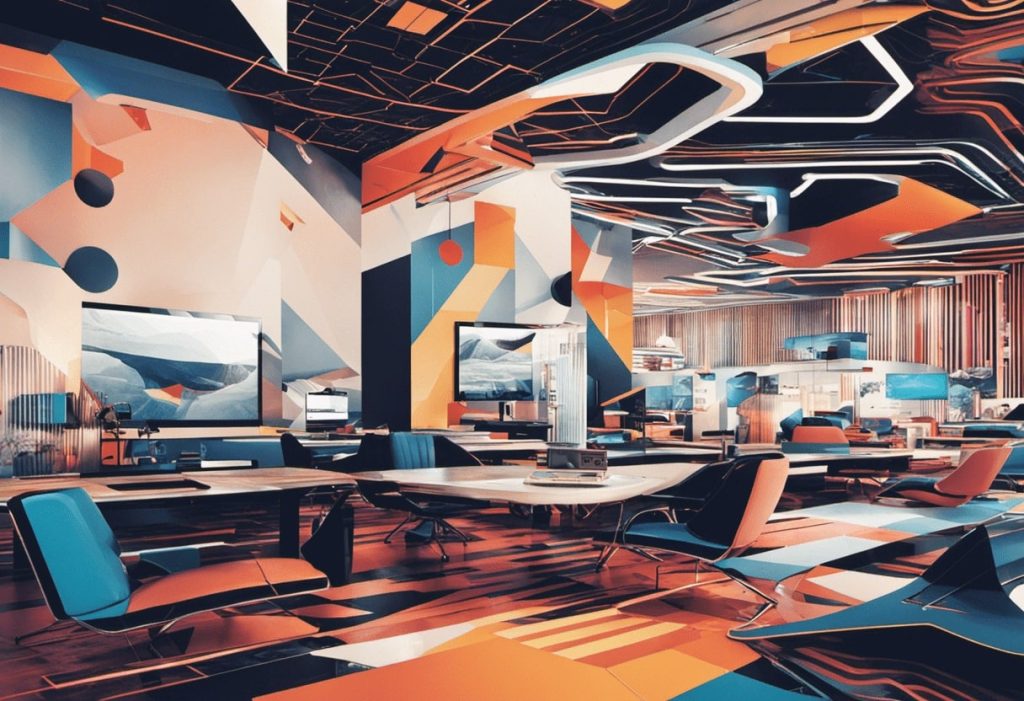
In the fast-paced world of the digital era, generative AI is rapidly becoming a valuable ally for professionals in graphic design and copywriting.
Graphics and design have become the cornerstones of the digital experience. A well-designed website immediately captures a visitor’s interest and guides them through information flow in a clear and engaging manner. A social media post with an eye-catching image is more likely to be shared and commented on, increasing engagement and interaction with the audience. And a product with attractive packaging stands out on physical store shelves and in the virtual platforms of e-commerce.
But the importance of graphics and design goes beyond aesthetics. Smart and intuitive design can enhance the usability of an application, making the user experience smoother and more rewarding.
The choice of colors, fonts, and visual elements can convey subtle messages and influence user emotions. Furthermore, responsive design has become essential in an era where users access content from a variety of devices, from desktop computers to smartphones.
In this context, design is no longer just a matter of aesthetics but a fundamental strategy for business success and effective communication. And in an era where content creation and sharing are more accessible than ever, the demand for skilled graphic and web designers is continuously rising.
Thanks to this cutting-edge technology, design professionals can benefit from a faster and more efficient content creation process. AI can automate repetitive tasks, allowing designers to focus on more creative and strategic activities; it can provide real-time suggestions and feedback, helping designers make more informed decisions and enhance the quality of their work. All of this translates into increased productivity and valuable time savings that can be invested in other project phases. This is how AI paves the way for innovation in design, enabling the exploration of new solutions, forms, and styles that might otherwise elude human creativity.
Let’s now explore the advantages of using Artificial Intelligence in the field of Graphics and Design.
Time and Effort Savings

For a creative professional, time is an invaluable asset. In the realm of graphic design and copywriting, every minute gained can translate into greater dedication to creativity and strategy. In this scenario, Artificial Intelligence (AI) stands as an extraordinary resource, capable of revolutionizing the approach of designers and copywriters to their profession.
Imagine having a virtual assistant at your disposal, always ready to tackle the most challenging and repetitive work, freeing you from tasks that would require hours of manual effort. This is AI at its best: a digital working companion that allows you to dedicate time to high-quality projects and creative experimentation.
The value of AI is not limited to task optimization. Thanks to its pattern recognition skills, AI can analyze a substantial volume of data and provide innovative and original suggestions.
This advanced analytical ability can significantly enhance creative efficiency, freeing professionals from the need to manually seek inspiration or ideas. In other words, AI doesn’t replace human creativity but enhances it. By collaborating with AI, creatives can explore new creative avenues and seize unexpected opportunities that might otherwise slip away.
In the end, AI is much more than a mere tool. It’s a reliable ally, capable of boosting productivity, freeing up time, and amplifying creativity. With AI by their side, creative professionals can take on more ambitious challenges and embark on projects that would have required much more time and effort without this technology. In this way, AI becomes a valuable resource, not only for improving workflow but also for stimulating innovation and progress in the graphic design industry.
Improved Object Recognition
Despite artificial intelligence may still face challenges in recognizing complex objects, its ability to identify simpler images and shapes is undeniable. This feature represents a tremendous advantage for creative professionals as it significantly simplifies the creation of visual content.
In an age where social media and engaging digital experiences are increasingly important, having tools that facilitate the production of quality images is crucial.
Artificial intelligence is built on advances in machine learning and image processing. Thanks to sophisticated algorithms, it can analyze a vast amount of visual data and learn from it to progressively improve its recognition capabilities.
This image recognition capability of artificial intelligence is a huge aid to creative professionals who can use these algorithms to expedite the creation process and enhance the quality of their visual content.
For example, an advertising graphic designer could use artificial intelligence to automatically identify and modify specific objects within an image without the need for manual identification. This saves time and yields more precise and effective results.
However, it’s important to emphasize that artificial intelligence doesn’t replace human creativity but complements it. While capable of recognizing and creating quality images, artificial intelligence lacks the critical thinking and emotional capacity characteristic of human beings.
Therefore, it’s the task of creative professionals to use artificial intelligence as a tool to expand their abilities and stimulate their creativity, adapting it to their needs and artistic vision.
Assistance in Creative Ideation
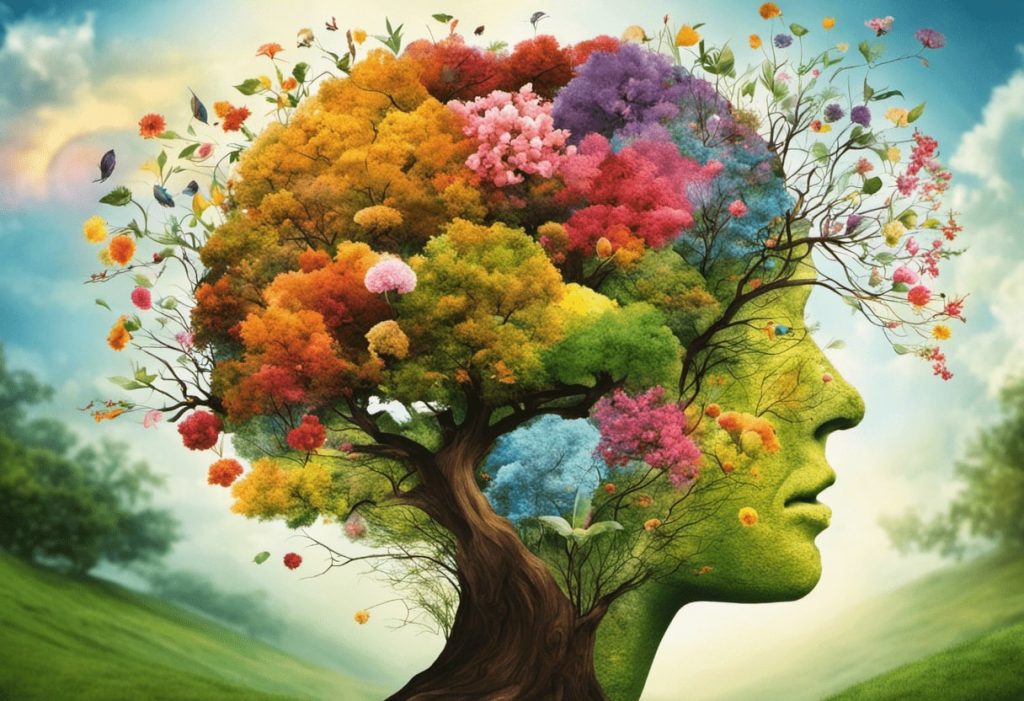
Generative Artificial Intelligence doesn’t simply perform predefined tasks; it’s also capable of generating ideas. This means it can gather images and text from a variety of sources, allowing the creation of mood boards and stimulating creativity in projects.
The collaboration between AI and human creativity opens new horizons for innovation, providing a continuous flow of ideas and concepts for professionals in the field of graphic design.
This technology can be seen as a creative partner, offering valuable input in the ideation process and project development. With its ability to access a wide range of sources, it can provide a great variety of inputs and stimuli for creative professionals. This means it can help overcome creative blocks, offering new perspectives and ideas that might not have been considered otherwise.
AI can function as a virtual assistant, aiding artists and graphic design professionals in finding inspiration and expanding their creative repertoire. It can gather images from websites, social media, and other online sources, filtering and selecting the most relevant or interesting ones.
An essential aspect of the collaboration between artificial intelligence and human creativity is the AI’s ability to learn from feedback and interactions with users.
When used in the field of graphic design, it can learn from professionals’ tastes and preferences, providing increasingly personalized and relevant suggestions over time. This ongoing learning process can lead to a unique synergy between artificial intelligence and human creative talent, yielding progressively more innovative and surprising results.
In conclusion, the integration of artificial intelligence into creative processes opens up new possibilities and opportunities for professionals in graphic design and copywriting. AI not only performs tasks but can also generate ideas and inspiration, offering a constant flow of creative input. This collaboration between AI and human creativity can lead to remarkable and innovative results, providing a competitive advantage in the fields of graphic design and visual content creation.
Workflow Enhancement
Artificial intelligence offers not only advantages in the creation of visual content but can also revolutionize the way we manage projects and clients. With its ability to generate original content, AI proves to be a valuable tool for significantly reducing the time spent creating high-quality images and content, allowing professionals to respond to client needs more swiftly and effectively. This leads to increased responsiveness in client interactions.
The introduction of AI in a professional context represents a significant opportunity to enhance performance and achieve superior quality results.
Image Editing with Generative Artificial Intelligence
In today’s digital environment, flexibility in manipulating images is crucial. Generative artificial intelligence is expanding the boundaries of what’s possible, making image editing not only easier but also deeper and more intuitive.
Machine learning algorithms not only suggest improvements like white balance and contrast but go beyond. You can change subjects’ clothing, remove or add elements like trees, animals, or buildings, and even alter lighting to create an entirely different atmosphere.
These advanced capabilities are democratizing design like never before. In fact, you don’t need to be an expert to create incredible images; with generative AI, the power to manipulate visual reality is now in everyone’s hands.
Let’s consider an example:
Imagine a marketing professional who needs to modify a photo for a seasonal campaign. With a generative AI solution, they could easily replace a model’s summer sweater with a winter coat or transform a sunny beach into a snowy winter landscape. Even an amateur photographer could remove unwanted objects or add a rainbow to add a touch of magic to their photos.
Ethics and Artificial Intelligence: Strategies for Harmonious Coexistence
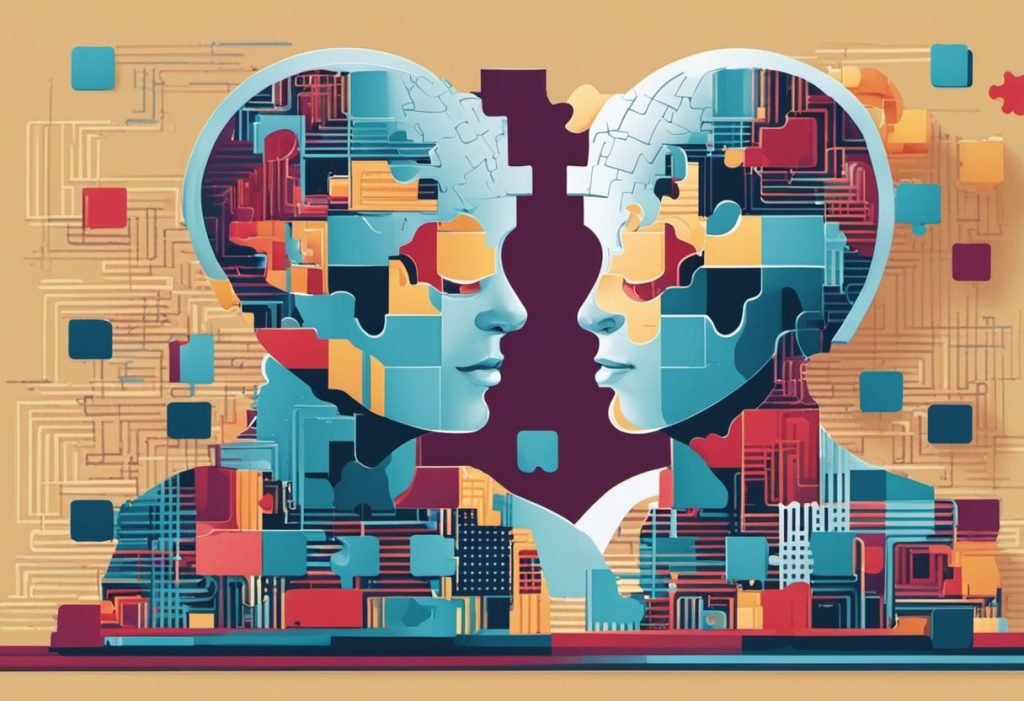
In the world of Artificial Intelligence (AI), complex ethical aspects come into play that have a considerable influence, and the design sector is not exempt from this. This topic is of great relevance, not only due to implications related to job loss and data privacy issues but also due to concerns that may arise regarding the interaction between AI and human mental processes.
However, it’s essential to emphasize that AI is not merely an obstacle to human mental processes; on the contrary, it offers intriguing opportunities for their potential amplification and improvement. It presents itself as an opportunity when a professional, if they are indeed a professional, benefits from using it.
It’s the skills and competencies of the professional that make the difference. It’s precisely the know-how that distinguishes a genuine professional from a fictional one.
AI, as a tool, is just that, a tool. Without the guiding human creative mind, it lacks intent, goals, and deeper meaning. Creative professionals, like graphic designers, copywriters, and artists, bring their intuition, vision, and discernment to the use of AI.
They provide the initial input, context, and direction to AI, allowing it to perform specific tasks more effectively and efficiently. This synergy between artificial intelligence and human creativity is what enables us to explore new frontiers in graphic design, writing, art, and many other fields. It’s the combination of AI logic and human inspiration that makes innovation and progress possible.
Ethics in AI isn’t just about dilemmas and challenges but also about creative solutions and an openness to new perspectives. In this context, ethical challenges can be overcome through constructive dialogue and the adoption of solid guiding principles.
It’s important not to view AI as a hindrance but as a tool that can be directed to enhance our abilities and expand our creative potential. Through a correct understanding and application of ethical principles, we can ensure that AI is used responsibly and in line with human values. This means considering privacy, transparency, fairness, and human well-being as fundamental pillars in the design and implementation of AI systems.
Furthermore, AI can be a valuable resource for solving complex problems that require a creative approach. An example is the use of AI in graphic design processes, where designers can collaborate with AI algorithms to generate innovative and original ideas. AI can analyze vast amounts of data, identify patterns, and provide suggestions, but the creative aspect and human intuition remain essential to bringing a work of art or unique design to life.
In summary, while ethical dilemmas in AI are manifold and complex, we shouldn’t consider them as insurmountable obstacles. Rather, they should serve as a stimulus to develop ethical approaches and innovative strategies that enable us to integrate AI responsibly and constructively into our world of design.
Artificial Intelligence Serving the Graphic Design of Large Companies
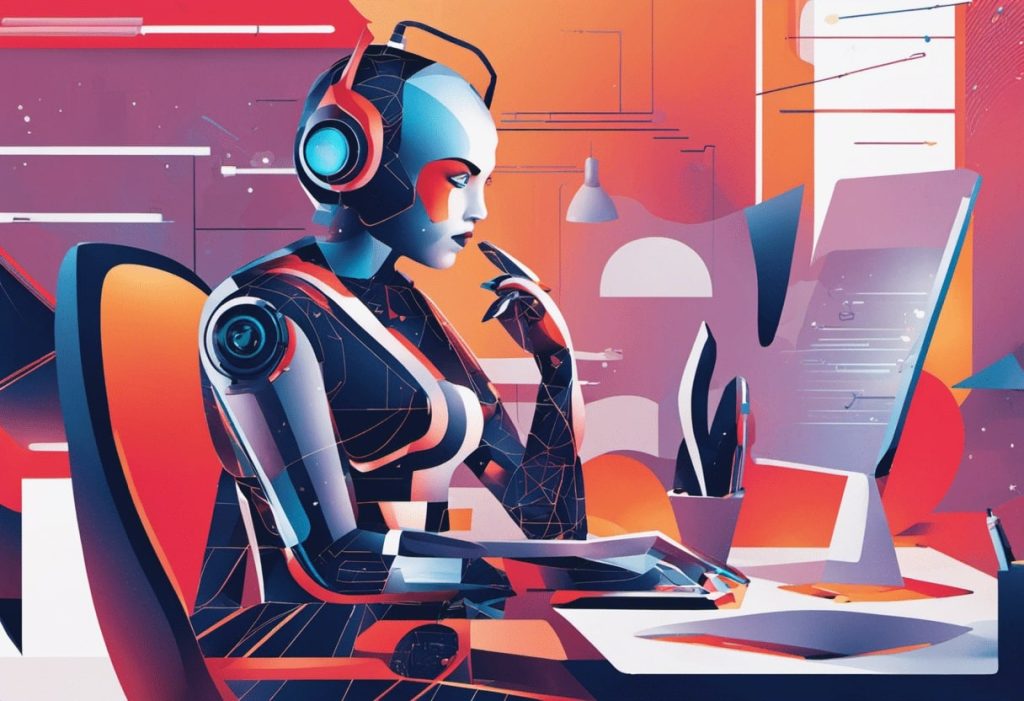
Artificial Intelligence has been developed to learn and provide precise answers to users’ questions to meet their needs and expectations. The latest AI-based solutions are designed to incorporate the best features available in the market and human expertise in various sectors.
In the context of graphic design, such as logo creation or a company’s graphic identity, Artificial Intelligence can offer high-quality solutions.
However, it’s the user who provides detailed input, described precisely, including details like shape, colors, and even the preferred font. For a minimal cost and in a short period, AI generates various design proposals. It’s up to the user to make the final choice from the high-quality proposals presented by AI.
Generative Design Applied to Engineering
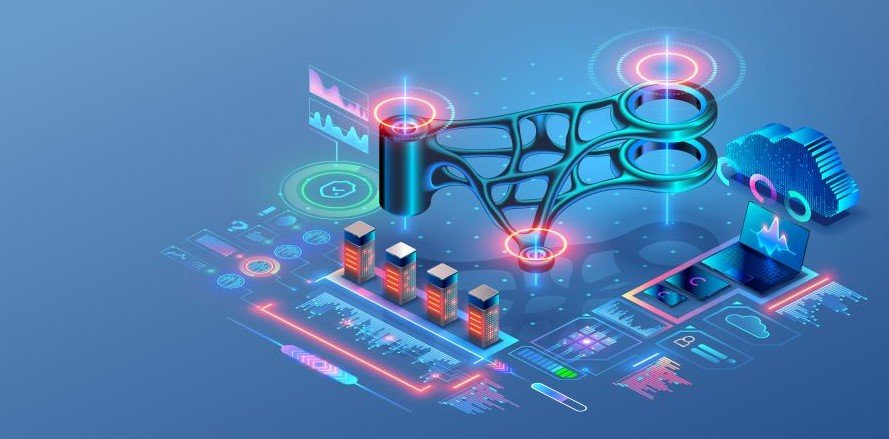
Generative design is an automated approach to creating geometries used in computer-aided design (CAD). This process leverages machine learning to generate models of parts and assemblies.
Unlike direct modeling techniques, generative design requires the user to outline the design space rather than the specific shape of the object. This involves the inclusion or exclusion of specific areas, taking into account operating conditions, materials, and production constraints.
In practice, after defining design parameters, an algorithm processes a series of potential solutions. These solutions can be viewed by the user, who is responsible for selecting the optimal choice among the proposed options.
Generative design stands out for its speed, as the algorithm can quickly generate several valid solutions to show the end user and often offers greater reliability than traditional iterative methods guided by human intervention.
This methodology has several advantageous applications in fields such as engineering and industrial design. For example, it can be used for the design of automotive components, aerospace products, or even furniture.
Its automation saves time and resources, offering greater efficiency in the design process while providing new creative opportunities, as the selection of the optimal choice can be influenced by user preferences and needs.
Like in every field, in this one too, AI doesn’t completely replace the role of human intervention in design. The knowledge and experience of operators remain crucial in the correct application of design parameters and in the evaluation of results generated by the algorithm.
Furthermore, not all types of projects can benefit from this methodology, and modifications and customizations may be required after the generation of potential solutions.
From the Human Mind to Algorithms: Nutella’s Innovative Project

In 2017, Ferrero’s Nutella turned to AI for a unique project, in collaboration with Ogilvy & Mather Italy. This partnership led to the creation of an algorithm that replaced the traditional designer, generating millions of unique packaging designs for Nutella jars.
The algorithm extracted a wide range of patterns and colors from a database and combined them into seven million variations of Nutella’s graphic identity. These unique versions were printed on jars in Italy and considered as genuine ‘works of art.’
The project, called Nutella Unica, was a massive success, with items flying off the shelves in Italian supermarkets in just thirty days. This innovative initiative aimed to make each Nutella jar special and personalized for every customer, demonstrating how algorithms can take art and creativity to a new level.
The collaboration between Nutella and Ogilvy & Mather Italy had a significant impact on the personalization of jars. Thanks to the use of AI, the algorithm exceeded all expectations, creating a unique experience for consumers. The patterns and colors extracted from the database were combined in an astonishing way, giving rise to seven million variations of Nutella’s graphic identity. Each jar became a work of art in itself, unique and special.
The popularity of Nutella Unica reached new heights, prompting people to flood Italian supermarkets in the hope of finding their personalized jar. The initiative hit the mark, showing how technology can elevate art and creativity. Every customer felt special, as if Nutella had designed the jar just for them.
Autodesk

Generative AI-based design has brought about significant changes in the construction industry.
The company Autodesk has used this technology to create an innovative research space. Thanks to the use of computer algorithms, artificial intelligence has been able to generate multiple optimal solutions, surpassing human capabilities.
This has resulted in a shift in the role of architects, who have transitioned from creators to reviewers. Generative design has demonstrated the ability to improve efficiency, reduce costs, and optimize planning in the construction process.
This innovation has also opened doors to new possibilities in advanced virtual design, enhancing the overall effectiveness of the creation process. It has been found that generative AI-based design has had a significant impact on the development of new materials for the construction industry as well.
The use of advanced algorithms has allowed the study of previously unimaginable material combinations, optimizing structural strength and energy efficiency in buildings. This new methodology has opened up new horizons in the research and development of eco-friendly materials that meet the needs of an increasingly environmentally conscious world.
Thanks to generative design, architects and engineers can create innovative structures that seamlessly integrate functional and aesthetic aspects.
Automotive and Aerospace Sector
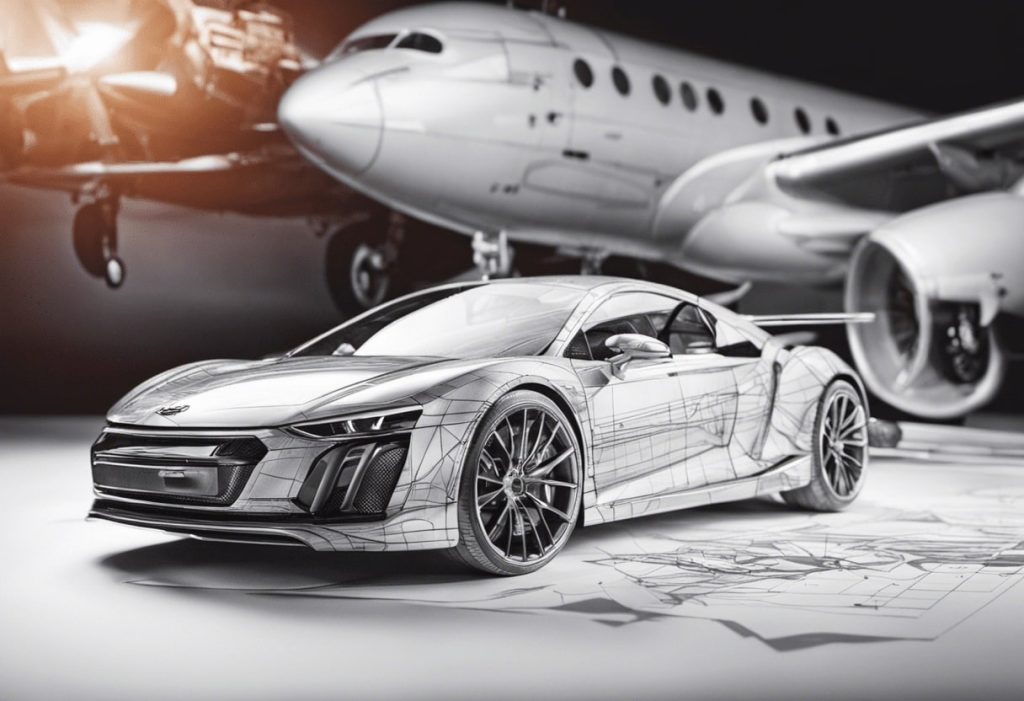
The introduction of generative artificial intelligence is having a revolutionary impact on the automotive industry, involving a substantial part of its phases: from engineering to production, to sales. This progress is accelerating innovation and productivity growth in the sector.
Generative artificial intelligence is also used in the development of autonomous vehicles, allowing them to create more advanced models and reduce the time required for the development of new vehicles. Generative AI is, therefore, a valuable resource for the automotive sector, enabling it to keep up with the new frontiers of technology and innovation.
The possibilities offered by generative AI are extending to multiple sectors, including design, marketing, sales, and production. In the field of automotive design, for instance, this technology is significantly reducing the time needed to move from sketches to usable 3D models. This is made possible by the use of advanced artificial intelligence models and datasets containing detailed vehicle images.
In addition, generative AI is contributing to the optimization of smart factories, reducing costs, and improving productivity. With this technology, some stages of the production process can be automated, increasing efficiency and enabling the production of high-quality vehicles.
Thanks to AI’s ability to analyze large amounts of data, more accurate predictions can be made about customer needs and market trends. This leads to a significant increase in productivity in the sales sector and enables companies to adapt more promptly to consumer demands.
With the increasingly widespread use of generative artificial intelligence, it is expected that the automotive industry will take giant strides towards the realization of fully autonomous vehicles, with enhanced safety and efficiency. Thanks to generative AI, it is possible to analyze and interpret a large amount of data in real-time from sensors, cameras, and navigation systems on vehicles, allowing for safer and more precise autonomous driving.
Moreover, generative artificial intelligence is also influencing how electric vehicles are developed and marketed. With this technology, it is possible to create advanced virtual models of electric vehicles, optimizing aerodynamics, battery capacity, and energy consumption.
For example
“Toyota, one of the world’s largest automotive companies, has developed a generative artificial intelligence technique to ensure that initial design sketches incorporate engineering parameters.
Meanwhile, Mercedes-Benz has demonstrated a ChatGPT-enabled voice assistant.”
Source: https://blogs.nvidia.com/blog/2023/08/09/generative-ai-auto-industry/#:~:text=,AV)
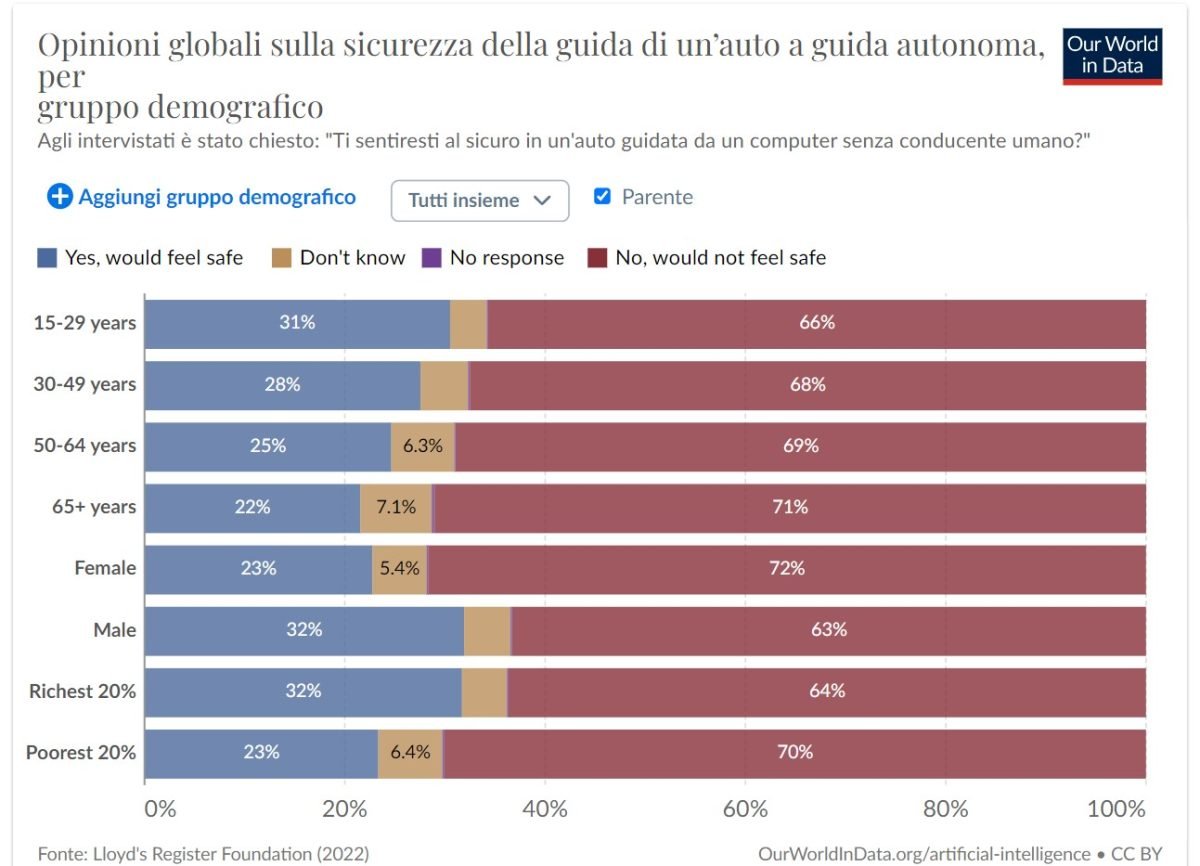
Source: Our World in Data
The Use of Generative AI in Graphic Design, in Numbers
While there are still few allies on our side at the moment, it’s interesting to take a look at the data and statistics that reflect the growing adoption and impact of Artificial Intelligence in our reality.
We know for sure that:
- Over 50% of marketing professionals believe visual content is essential for their marketing strategy (Source: Vendetta).
This implies that both images themselves and the tools for editing and generating images are taking on an increasingly important role in the current context. Images have become a very powerful means of communication, capable of capturing people’s attention and conveying messages effectively. In addition to this, the use of image editing tools allows for creating and customizing images to specific needs, improving their quality and overall appearance.
Furthermore, social media and multimedia sharing platforms have amplified the reach of images, allowing them to reach a vast global audience.
Image editing tools have become indispensable for anyone looking to create and enhance their images. These tools, available as both software and apps, offer a wide range of features for making changes and improvements to images.
Moreover, image editing tools have become accessible to everyone. With numerous free apps and software available, there’s no need for advanced skills or expensive programs to edit images.
- One-third of marketing professionals believe that producing visual content consistently is their biggest challenge with content production. (Source: Vendetta)
This phenomenon hampers workflow and causes it to proceed at a slower pace than expected or desired. This can lead to a range of negative consequences affecting productivity and goal achievement. For instance, tasks may take longer than anticipated, leading to project delays or customer dissatisfaction. Furthermore, if the workflow slows down, there may be a decrease in the quality of work, as people may feel more stressed or less motivated to do their job well.
A recent study conducted by Salesforce on the adoption of generative Artificial Intelligence revealed a clear division between those who use this technology and those who do not among the general public in the United States, the United Kingdom, Australia, and India. The results of online interviews conducted in each country show the following adoption levels (cultural influences may impact the results):
- 73% of the interviewed Indian population uses generative AI.
- 49% of the interviewed Australian population uses generative AI.
- 45% of the interviewed U.S. population uses generative AI.
- 29% of the interviewed UK population uses generative AI.
In detail, the survey found that users of Artificial Intelligence are considered ‘super-users,’ underscoring that the majority of them make frequent use of this technology and feel confident in learning and using it. In fact:
- 65% of generative AI users are Millennials or Gen Z, and 72% are employed.
- Nearly 6 out of 10 users believe they are on the right track to master the technology.
- 70% of Gen Z reports using the technology, and 52% of them use it for making informed decisions.
- 52% say they use generative AI more now than when they started.
These early adopters are also looking to expand the generative AI use cases from fun and games to business and work applications:
- 75% of generative AI users are trying to automate tasks at work and use generative AI for work communications.
- 38% of generative AI users use it for fun, and 34% use it to learn about topics of interest.
While users of Artificial Intelligence are predominantly young and enthusiastic, those who do not use AI are generally older, less familiar with the technology, and more inclined to express skepticism about its benefits.
- 68% of non-users are Gen X or Baby Boomers.
- 88% haven’t fully understood how generative AI will impact their lives.
- 40% state they lack enough familiarity with the technology, and 32% claim the technology is not useful to them.
Non-users are still the least confident and least experienced. They are the ones watching from a distance, waiting for generative AI to be more integrated into their lives and the technologies they already use to gain more security and knowledge before diving into the world of generative AI.
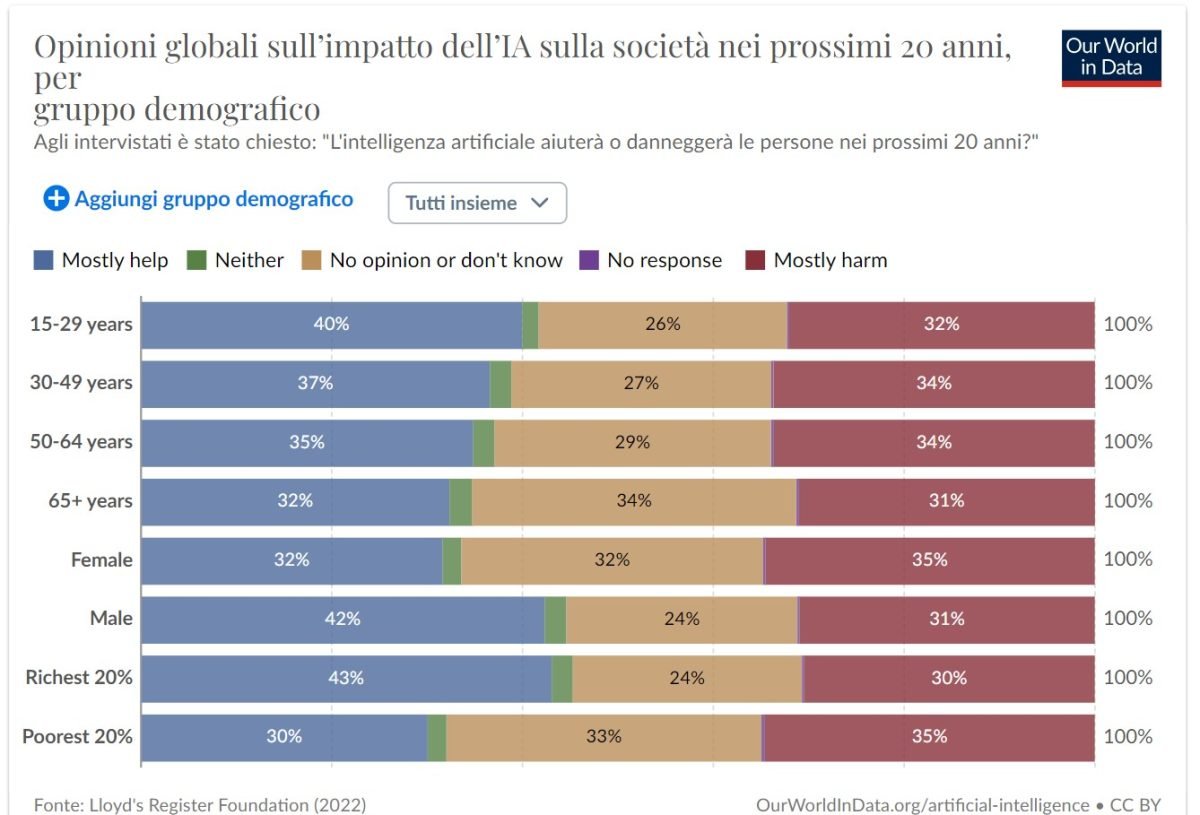
Source: Our World in Data
Recent research conducted by Salesforce provides a complex picture in which workers exhibit a dual mindset.
Certainly, there is clear recognition of the benefits of generative AI among its users. Most of the interviewees believe that this technology can enhance customer service and increase the return on technological investments, such as artificial intelligence models and machine learning. However, this positive outlook is accompanied by some fundamental concerns.
One of the main concerns is about the accuracy of results generated by AI. About half of the workers fear that such results may always be inaccurate, while an even greater percentage worries that they may be biased.
Furthermore, there is a strong sense of uncertainty regarding security. The vast majority of interviewees believe that generative AI poses new security risks, raising important questions about managing sensitive data within this technology.
One of the most interesting pieces of data concerns the perception of business leaders compared to individual contributors. Leaders seem to be more confident in their ability to use generative AI safely, while individual workers express a higher degree of uncertainty.
The research emphasizes the need to address these concerns and bridge the gap between the adoption of generative AI and its effective use. Employees have identified key elements such as human supervision, stronger security measures, reliable customer data, and ethical usage guidelines to ensure responsible and safe use of generative AI in business.
Source: Salesforce – Generative AI Statistics for 2023 – Salesforce News
The Challenges of AI in Graphic Design: A Detailed Analysis of Current Barriers
The integration of Artificial Intelligence in the field of graphic design has undoubtedly opened up new perspectives and possibilities, but we cannot ignore the challenges that still exist. A detailed analysis of current barriers reveals that AI in graphic design is still limited in several aspects.
For example, while algorithms can easily generate layouts or select colors, human creativity and lateral thinking remain beyond AI’s reach. Furthermore, AI’s understanding of human context and emotions is an area of ongoing development.
AI in graphic design must overcome these limitations to provide truly innovative and personalized results. Only through further development of machine learning capabilities and the integration of broader contextual data can current challenges be addressed and optimal use of AI in graphic design ensured.
Additionally, another fundamental aspect that AI in graphic design must address is, as we have extensively discussed, the issue of ethics. The use of AI raises a series of questions related to privacy and the responsibility of choices made. We are aware that AI can be a great aid in creating compelling and original designs, but we must also consider the risk of perpetuating stereotypes or creating inequalities through discriminatory algorithms.
It is essential for experts and developers in the field of graphic design to engage in the creation of ethical and fair AI systems. Emphasis must be placed on inclusion and diversity, ensuring that AI’s decisions reflect values of fairness and respect.
We must also consider the economic impacts of AI integration in graphic design. It introduces a new dynamic in the industry, allowing for automation of some tasks and reduction of work times. However, we must be aware that this may lead to a decrease in demand for professionals in the industry.
It is important, therefore, to plan a fair transition to this new reality, offering training and requalification opportunities for anyone interested in working with AI in graphic design. Furthermore, we must also consider the issue of copyright and original works, as AI can be programmed to generate designs similar to existing ones.
As we’ve seen, the integration of AI in the field of graphic design has opened up new opportunities and challenges. However, if approached ethically and responsibly, these challenges can be overcome to provide innovative and personalized results. Achieving this goal requires collaborative work between AI experts, graphic design professionals, and end users.
Establishing a continuous and open dialogue between these parties will help better understand user needs and expectations, ensuring that AI systems in graphic design are truly useful and relevant.
Additionally, it is crucial to invest in research and the development of new technologies that allow AI to better understand and interpret human emotions. This ability to adapt to users’ emotional context will enable the creation of more effective and engaging graphic designs.
Conclusions
In conclusion, the implementation of AI in the fields of graphic design and copywriting is much more than just a technological novelty. It is an invaluable resource that offers a series of tangible and measurable advantages. From improvements in productivity to the enhancement of creativity, AI is redefining how professionals in these fields operate and produce high-quality content.
This technology is fundamentally changing how we design, create, and interact with visual content, opening up new possibilities and challenging past conventions.
One of the keys to the success of this transformation is the synergistic integration between AI and human creativity. AI is a powerful tool capable of streamlining workflows, suggesting innovative ideas, and analyzing complex data. However, it is the human mind that imparts meaning and purpose to this technology. It’s the creative professionals who set the vision, make strategic decisions, and turn ideas into tangible reality.
Artificial Intelligence is here to stay, and its integration into the world of graphic design is just the beginning of an exciting and innovative journey. As we embrace this new era of AI-assisted creativity, we can confidently look forward to a future where the collaboration between artificial intelligence and human creativity brings forth extraordinary works and astonishing visual experiences.
